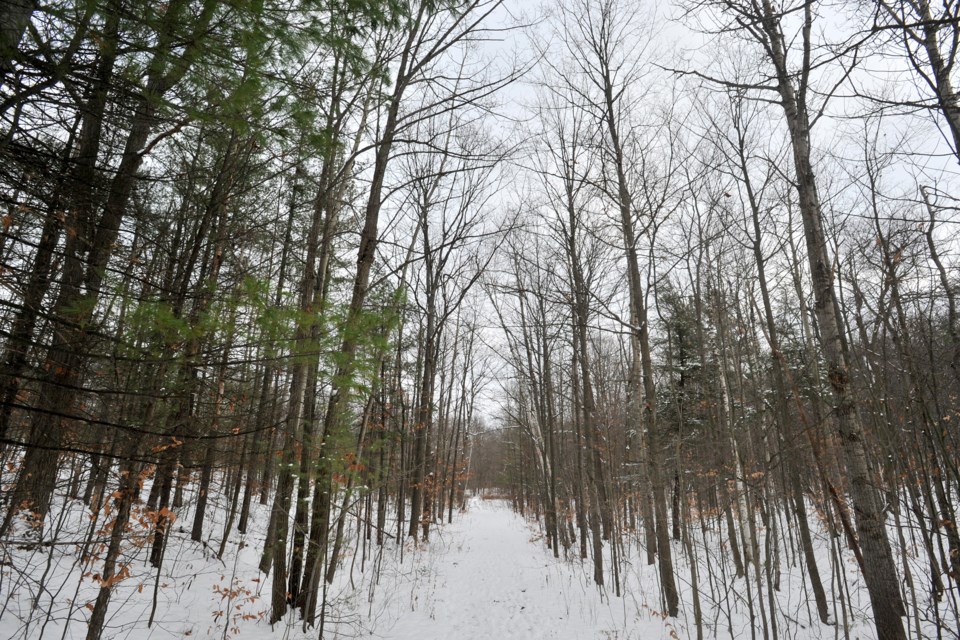You may not have noticed it because they take so long to grow, but Simcoe County’s forests are constantly changing.
More than a hundred years ago, in 1922, Simcoe County became the first region in Ontario to enter into what was called the 'Agreement Forest' program, originally established to rehabilitate the county’s vast wasteland of sandy soils.
In the early years of the program, more than one million trees were planted each year, most of them pine.
Today, there are approximately 20 million trees in the county’s forests, which occupy almost 14,000 hectares (about 34,000 acres), making it the single largest municipal forest in the province.
According to Graeme Davis, Simcoe County’s forester, planting has slowed down considerably.
“We actually harvest far more than we plant,” he explained. “The early forests are maturing at the same time and those original pine plantation forests are starting to convert into a mixed natural forest type.”

As the oldest parts of the forests begin to reach maturity — 70, 80 or 90 years after being planted — the trees fall or are harvested as part of the county’s woodlot management.
When those trees are removed, the canopy opens up, allowing sunlight to reach the forest floor below, providing essential sunlight to other tree species whose seeds have been transported into the forest via winds or animals.
Davis says the current makeup of the county’s forest is 50 per cent pine plantation and 50 per cent is natural forest cover.
According to Davis, county forests are “working forests’ — meaning they are managed for a range of benefits, including timber and economics.
Davis says the county harvests almost 30,000 cubic metres of broad timber each year, which generates about $2 million annually.
“We’ve been growing for a century and we continue to grow because we run the forest at a surplus,” Davis says. “All of the revenue that comes from the forest gets reinvested in the forest.
“We’re fairly lean and we always have positive cash flow that remains in reserves, so as opportunities come up we’re prepared."
Being prepared in the forestry world is far different than being prepared in almost any other field.
According to Davis, foresters have to be multi-visionaries. They have to be able to look 80 to 100 years into the future because it takes that long for a new forest to mature while at the same time being aware of what’s happening in the moment, especially as it relates to diseases and insect infestations.
Davis says insects are one of the biggest threats to the county forest, among them the spongy moth (formerly known as the European gypsy moth), forest tent caterpillars, emerald ash borer and a host of others.
“Spongy moth will be back,” he says. “Our first bad invasion was 30 years ago, but it’s sort of settled into a typical rotation where every seven to 10 years the population starts to spike again. It’s a cyclical problem.”
According to Davis, the problem reached an extreme level a couple of years ago.
“The world was falling and all of our forests were going to die,” he says, recalling the hysteria that accompanied the last infestation of spongy moth. “History tells us it’s going to crash, and it did.”
Davis says there are viruses, diseases and fungi that get into a forest population and essentially wipe it out overnight.
“People won’t even know it’s around,” he says. “It will be out there in low numbers and in another seven or 10 years it will uptick again and then crash. It’s a fairly typical cycle.”
Davis says minor pests have been around forever, but we’re seeing more exotic and invasive pests because southern Ontario is a “hot bed of international trade.”
He says insects like the emerald ash borer enter Canada as stowaways — living in and feasting on wooden shipping pallets that move products from country to country.
Davis expects we will see another infestation of Asian long-horn beetle and there’s a new Asian version of the spongy moth of which foresters have to be aware.
“There are a lot of insects that could arrive, diseases that could arrive,” Davis says. “There’s been a real change in our forests because of invasive plants as well.
“We spend considerable resources controlling different invasive species in our forests."
Working to ensure a healthy forest is paramount for Davis and his forestry crew.
“Forests provide a multitude of environmental, social, and economic benefits to the county,” he says, including protection of wildlife habitat and water resources, public education, recreation, scientific research and the production of wood products. “Remove that forest cover and you’ll see some dramatic negative impacts.”
The largest impact, Davis says, will be seen in the spring.
“With no forest, there’s no shade for the snow pack that’s accumulated over the winter. With no shade, there will be a faster runoff. With no tree roots to stabilize the soil or hold it in place, the soil will erode and will build up downstream," he says.
‘With no trees, there’s no shade to keep the water cool, no cool water means no trout or other cold water species. And on it goes.”
